Nature Photography by Richard L. Bowman
Flowers & Plants Blog
Flowers & Plants Blog
Elise and I lived for three years in Belize (1970-73), and had not been back since we left. But Belize has always had a special place in our hearts. So after our retirement in 2012, we made a return visit from September 20-October 1, 2012. Below are a few photos from there. Visit my other two nature blogs and my return visit page for more photos.
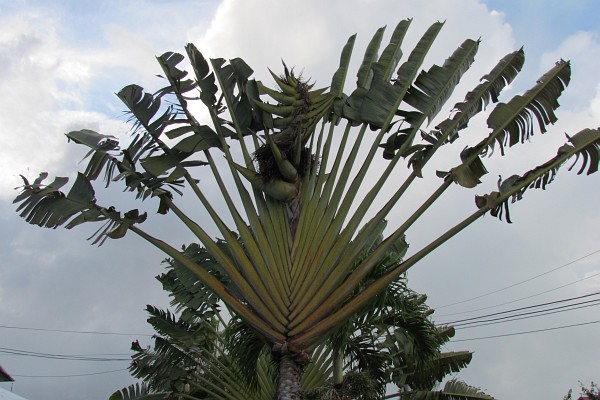
Travelers Palm, Belize City, Belize (15-Feb-13; © Richard L. Bowman)
Neighbors to our hosts (Betty and Roger Taylor) in Belize City had the above Travelers Palm in their yard. The Travelers Palm is not a true palm; it is related more to the banana plant and Bird-of-Paradise flower. Read the article in Wikipedia for more information.
http://en.wikipedia.org/wiki/Ravenala
One true palm that we knew from the years we lived in Belize in the early 1970's is the Cohune Palm. It's nuts would be pounded to get the oil from them. This oil would then be sold in recycled beer bottles in the local open-air markets.
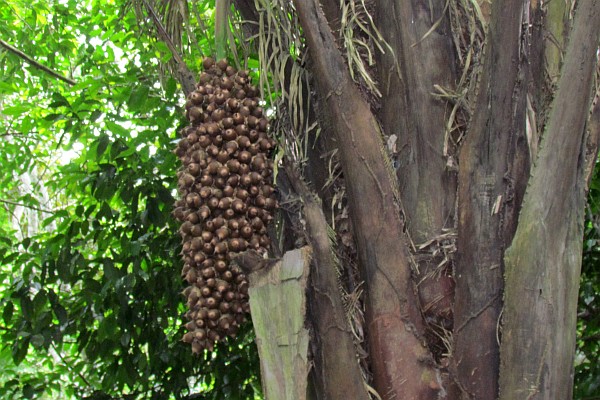
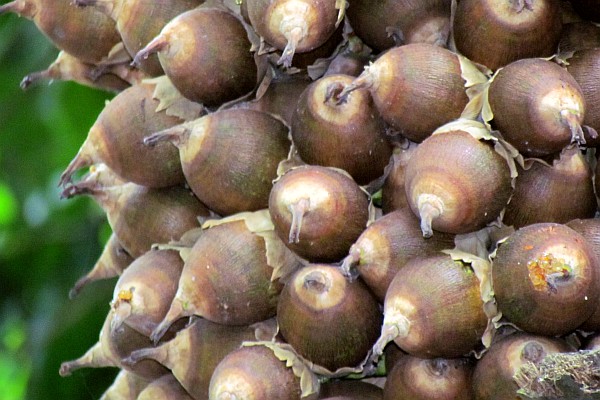
Cohune Palm tree and nuts, Cahal Pech Mayan ruins, Cayo, Belize (27-Sep-12; © Richard L. Bowman)
For some more information on the Cohune Palm in Belize, check out the following blog/journal.
http://ldfieldjournal.wordpress.com/2012/04/05/corozo-aka-cohune-palm-multi-purpose-maya-tree/
At least five years ago, and possibly closer to ten or even more, I saved a small foliage plant from a planter my wife or I were given as a gift, probably at the death of one of our parents. (And it is dreadful that we forget the occasion!) But the plant has survived and grown to 18 inches (46 cm). For identification, I am again in debt to Dr. Edgar Lickey, assistant professor of biology at Bridgewater College. Since I grew up in the farming communities of Lancaster County, PA, USA, I like the name--Cornstalk Dracaena or Corn Plant.
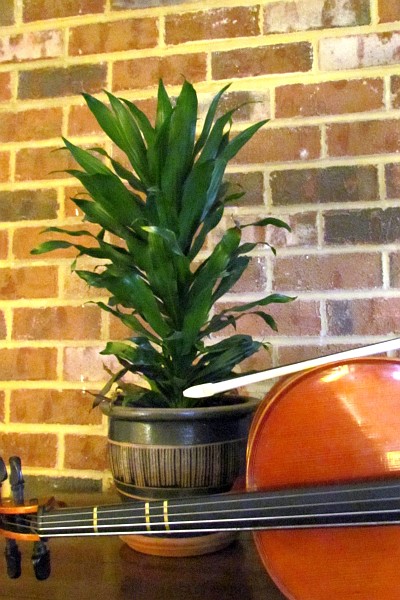
Cornstalk Dracaena in our home, Harrisonburg, VA, USA (15-Feb-13; © Richard L. Bowman)
According to the "Guide to Houseplants" web site, this house plant can reach 15 feet (6 m).
http://www.guide-to-houseplants.com/corn-plant.html
But Wikipedia says that in outdoor settings in Africa it can reach 49 feet (15 m), and it also shows small white flowers. So I have something to look forward to if the plant lives long enough and I don't mistreat it.
I had asked for possible identifications of the insect on the butternut squash posted three days ago. But since no one helped me out, I went to my resident biologist. OK, I am now retired from Bridgewater College, but Dr. Edgar Lickey, assistant professor of biology, is still a friend and he volunteered to do any identification I need done--well, almost any!
Ed suggested that it is one of the hoverflies (sometimes called flower flies, drone flies or syrphid flies), but since there are ~6000 species, he was not sure which one. Wow, I got as close as calling it a wasp or a fly. And while they do not sting, they do mimic wasps (for protection). For more info, visit "All about Hover Flies" at:
http://www.microscopy-uk.org.uk/mag/artmay07/cd-hoverflies.html
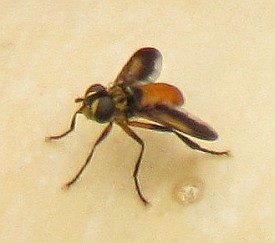
Close-up of a Hoverfly on a Butternut Squash, Harrisonburg, VA, USA (24-Sep-11; © Richard L. Bowman)
For all of the neglect I give our garden, it has been productive over the 24 years we have lived in this house. The Butternut Squash pictured below, form the summer of 2011, is just one example. As winter wanes (or doesn't), we can ponder the months ahead. BTW, what is that insect roaming on the skin of the squash?
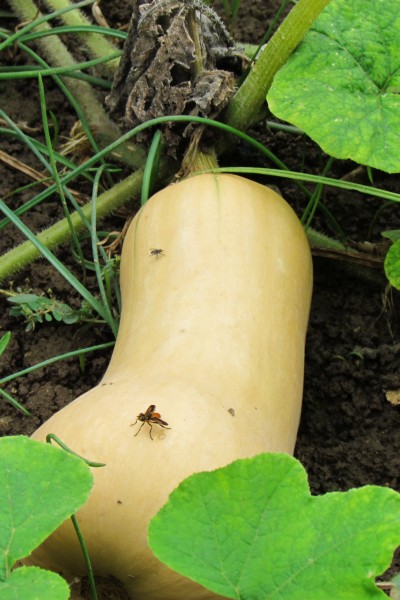
Butternut Squash, Harrisonburg, VA, USA (24-Sep-11; © Richard L. Bowman)
This summer I hope to put more time into the garden since I have retired from being a professor. But Elsie reminds me that I still have lots of "irons in the fie," so we shall see.
On my quest to fully identify all of the flowers I have pictured on this blog, I asked the staff and faculty at Bridgewater College (from which I retired in June), to tell me what the large red flower was at the bottom of this blog. Someone replied that it was an hibiscus. It seemed too large for the varieties I was acquainted with. Our backyard bush is approximately an eight-foot sphere of foliage and blooms each summer. These blooms are on the order of 2 1/2 inches (7 cm) across.
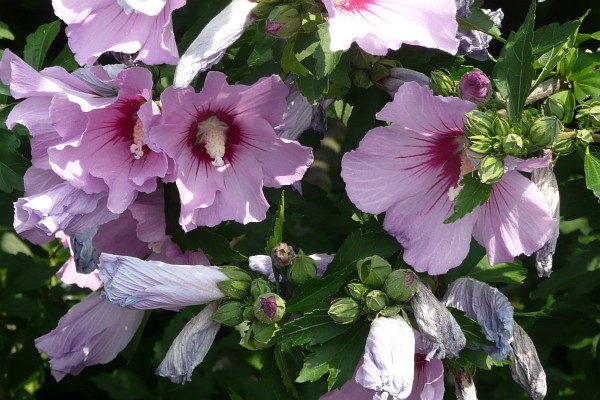
Mauve Hibiscus blooms, Harrisonburg, VA, USA (20-Jul-09; © Richard L. Bowman)
But the flower, whose bloom I showed at the bottom of this blog, was only one of a two or three and they occurred on five-to-six feet tall stalks rather as a bush. And each bloom was on the order of 6 inches (16 cm) across.
However, my sister (in whose yard the flowers were) verified that they are red hibiscus flowers, and she said she planted them originally but that they reseed themselves annually. Below is one of the blooms in context of the sign designating her house as a certified wildlife habitat.

Hibiscus (flor de Jamaica), Silver Spring, MD, USA (16-Jul-12; © Richard L. Bowman)
If you are interested in getting your house and land certified as a wildlife habitat, visit "Garden for Wildlife" pages at the National Wildlife Federation web site:
http://www.nwf.org/How-to-Help/Garden-for-Wildlife.aspx
As to a piece of additional interesting information, these large red hibiscus flowers are also called "flor de Jamaica" in Mexico and other parts of Central America and when dried these petals are used to make "Jamaican (or Hibiscus) tea."
Below are several photos I have taken in the past few months. The are presented in reverse chronological order. (I have identified the Joe-Pye Weed flowers and added a Milk Weed plant photo today. --Feb. 5)

Christmas Cactus in Bloom, Harrisonburg, VA, USA (24-Jan-13; © Richard L. Bowman)

Joe-Pye Weed along Trail, Blacksburg, VA, USA (19-Aug-12; © Richard L. Bowman)
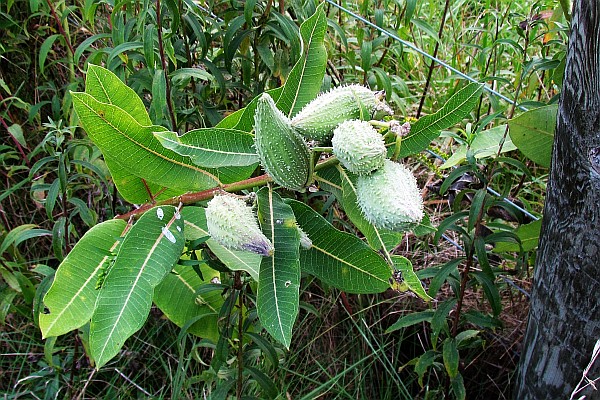
Milk Weed along Trail, Blacksburg, VA, USA (19-Aug-12; © Richard L. Bowman)

Thistle Flower along Trail, Blacksburg, VA, USA (19-Aug-12; © Richard L. Bowman)

Red Hibiscus Flower, Silver Spring, MD, USA (16-Jul-12; © Richard L. Bowman)
Check back from time to time, and check my other nature blogs--animals (mainly birds) and flowers. I'll try to post new photos here once a month or so.
--©2013, Richard L. Bowman